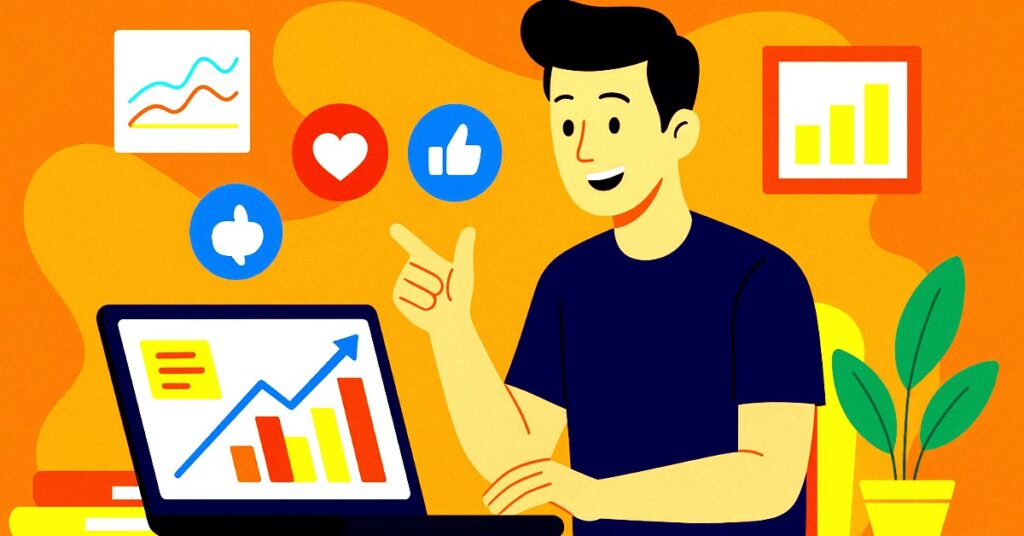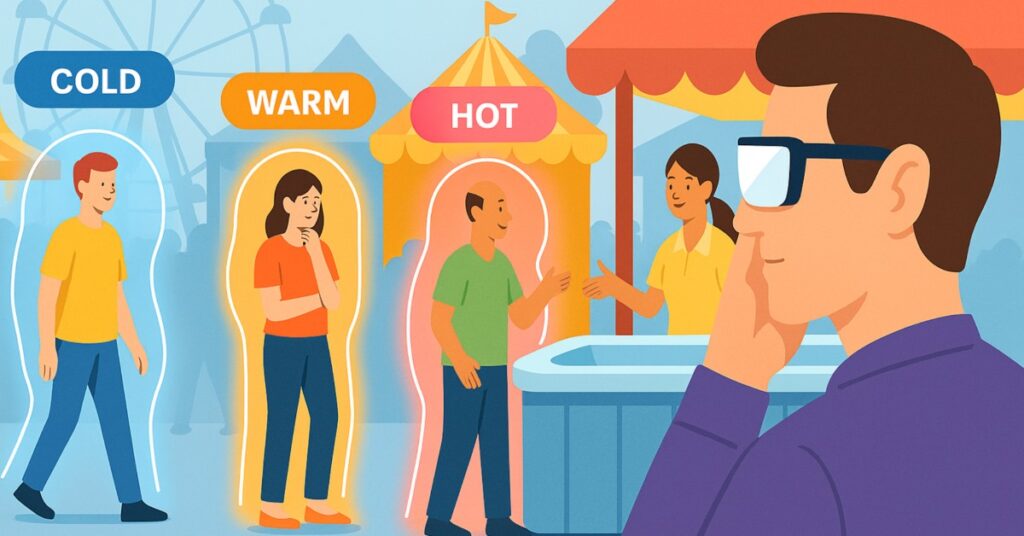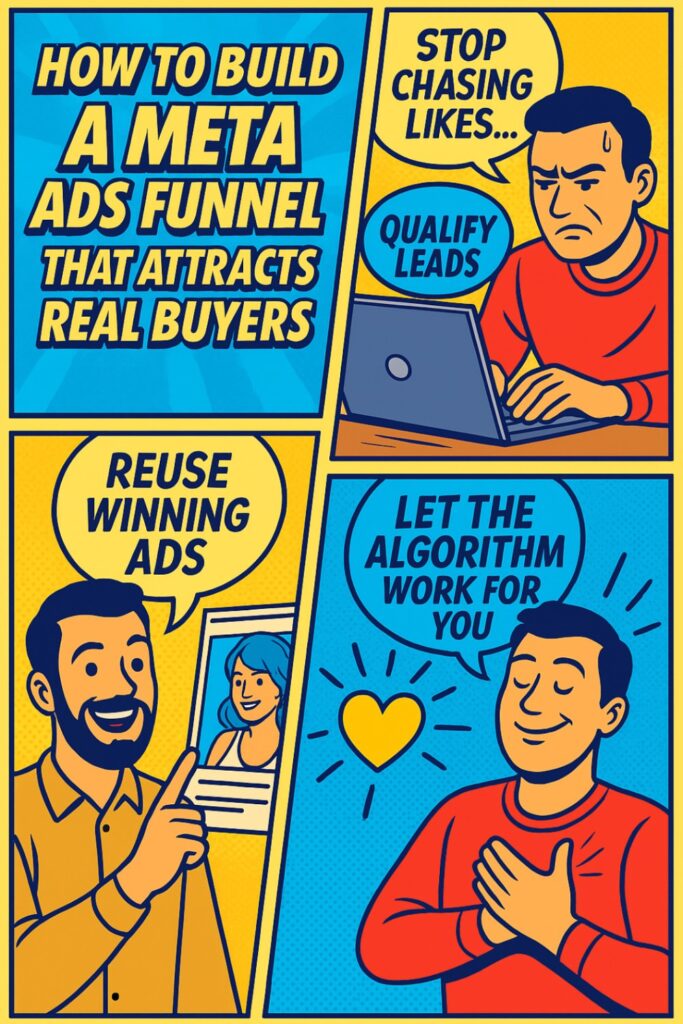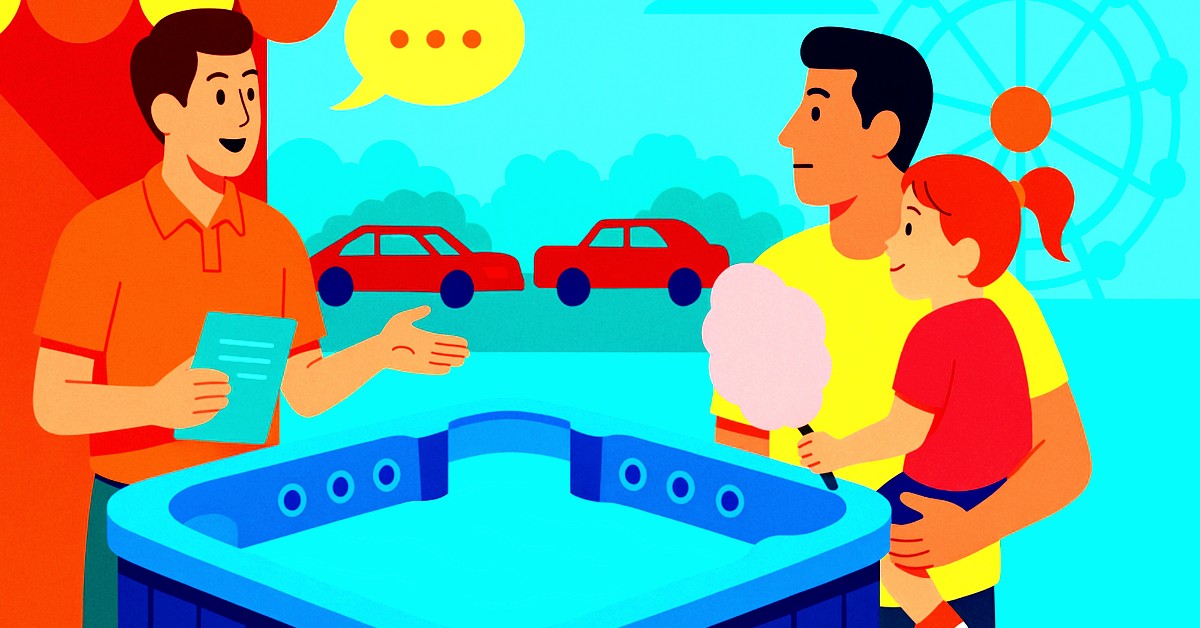- Why Most Advertisers Burn Cash and How to Stop Doing It Today
- How to Qualify Leads Before You Waste Budget or Time
- How Meta Ads Machine Learning Works
- Why Post IDs Are Your Secret Sauce (Most Advertisers Miss This)
- How to Make Your Meta Ads Funnel Work
- Got Questions About Meta Ads?
- Meta Ads Terms That Make You Sound Smart
- Ready To Scale Your Meta Ads Funnel?
I can trace every big win I’ve had in marketing back to a sweaty carnival tent, a stack of hot tub brochures, and one lesson I didn’t see coming.
Long before I was helping six-figure businesses scale toward seven figures or managing ad budgets in the millions…
I spent one unforgettable college summer selling hot tubs at carnivals.
Yes, that was a real job.
And yes, it was as chaotic as you imagine.
I was the sweaty guy in the hot tent, shouting over the rumble of demolition derbies and the heckling from clown faced dunk tank agitators.
I waved down funnel cake eaters and balloon chasing families, catching the drifting eyes of strangers in the heat. Anyone who looked my way was met with a sunburned sermon on backyard hydrotherapy.
Stress relief. Muscle recovery. Family time. More jets. Quiet heating. Ergonomic seating. Safety features.
All of it pitched against the backdrop of the midway’s sugar rush, as I tried to convince moms and dads wrestling with overstimulated toddlers clutching melting ice cream cones that dripped down their arms that today, of all days, was the perfect day to buy a ten thousand dollar hot tub.
It never was.
I dumped features because I did not know better. I mistook activity for progress because people smiled, nodded, and walked away with a flyer.
And that is exactly how most businesses run their ads. Shouting into the noise, chasing the wrong people, and wondering why nobody is buying.
Why You’re Burning Cash and How to Stop Doing It Today
This was years before the internet was a thing. I did not know pixels, algorithms, or event tracking. I only knew what it felt like to pitch the wrong people for hours.
At the carnival, I thought I was winning. Every smile, every nod, every brochure taken felt like progress. But none of it paid the bills.

That is exactly what vanity metrics look like in ads. Likes, views, and shares that feel good in the moment but do not turn into leads or sales.
They look like progress, but they are just polite interest dressed up as success.
Less experienced (and even some very experienced) ad agencies and gurus often use vanity metrics to impress clients who do not know any better.
They can be useful as indicators and may help lower ad costs, but if they are all you focus on, you will not make payroll.
Attention is not the same as intention. If your funnel is full of cold traffic that will never buy, your results will stay stuck.
How to Qualify Leads Before You Waste Budget or Time
One afternoon, a veteran sales rep named John pulled me aside.
He was the kind of oldtimer who had sold everything worth selling, from life insurance door to door to pots and pans in cramped kitchens.
He leaned in, stale coffee on his breath, words that had been waiting years to escape. His skin was weathered, his voice worn to gravel.
“Hey Kid. You’re talking to everybody like they’re gonna buy. They’re not. Some don’t want what you’ve got. Some can’t afford it. And some… They are happy to waste your time just to watch you work. Find the ones who matter — and don’t let them walk away.”

He was right. Some people were never going to buy. They just wanted shade, a free bottle of water, or a place to rest.
Others lit up at the mention of jets or the tankless water heater, or asked about delivery and setup. Those were the ones worth my time.
That advice changed everything.
Whether I was selling hot tubs at a carnival or running a Meta funnel for a client, the rule is the same.
Qualify early.
Online, that means using your copy, creative, and funnel steps to filter out the wrong audience before you spend another dollar reaching them.
When someone is interested, slow down and ask the simple questions that reveal timing, budget, and fit.
You are not pitching everyone. You are having a real conversation with the right people.
How Meta Ads Machine Learning Works
Back at the booth, I had no way of knowing who was ready to buy. I threw my pitch at anyone within earshot and hoped for the best.
Now imagine a pair of magic marketing glasses that made in-market buyers glow like neon. That is what a clean measurement setup gives you.
With a working pixel, server-side events, and first-party data, Meta can put your ads in front of people already in-market. From there, Meta sees who pauses, clicks, watches, visits your site, and explores your offer.

The system learns, and your delivery sharpens, putting your offer in front of the people most likely to take action.
That is how you get the right message to the right person at the right moment.
Meta is not trying to burn your budget.
It is protecting the user experience.
The better your content makes people feel, the more Meta rewards you with reach, lower costs, and sharper targeting.
Why Post IDs Are Your Secret Sauce (Most Advertisers Miss This)
At the carnival, I had to start from zero with every pitch. No memory. No momentum.
Even if someone liked what I said, there was no easy way for that enthusiasm to spread. Maybe they’d tell a friend to stop by my tent, but that almost never happened.
Meta works differently.
Every ad you run on Meta or Instagram is actually a post, and every post gives people a way to easily spread word of mouth with comments, likes, and shares.
And each post has a unique Post ID hidden in its link. Think of it like a mini landing page with a built-in memory.
Every like, comment, share, save, and click is tied to that ID.
Reuse the Post ID and you keep all that momentum. The social proof stays. The machine learning gets smarter.
And when your ad history signals quality, your ad gets shown to more of the right people for less money, which results in cheaper CPMs, stronger reach, and better ROAS.
Reusing Post IDs isn’t laziness. It’s leverage.

Build a Meta Ads Funnel That Actually Converts
A working Meta funnel isn’t about shouting louder.
It’s not about stacking likes or chasing cheap clicks.
It’s about knowing where your buyer is in the journey and showing up with the right message at the right time.
- Drop the vanity metrics.
- Focus on real signals.
- Qualify leads with data.
- Reuse proven creative.
Let Meta do what it does best.
Match your offer with people already in the market to buy.
Because here’s the thing…
Nobody becomes the top hot tub salesman at a small-town county fair by talking to everyone.
(And yes, I don’t mean to brag, but I really did sell the most hot tubs that summer at the Sullivan County Fair in Forksville, Pennsylvania.)
I won by finding the people who were ready to buy, and keeping their attention until they bought.
Meta works the same way.
When someone shows interest, the algorithm knows how to bring your message back at just the right moments, until they’re ready to say yes.
That’s when selling stops feeling like chasing… and starts feeling like winning.
Find the buyers. Keep the momentum. Let the system work for you.
And if you need help fixing your funnel, let me know.
Meta Ads Terms That Make You Sound Smart
Here are some of the terms you’ll hear tossed around in the world of Facebook and Instagram ads. So whether you spend all day in Ads Manager or you’re just getting started, you’ll understand what they mean and how they can help your campaigns work better.
- Cold Traffic: People who have never heard of your business before and have no prior relationship with your brand. In Facebook Ads, cold traffic targeting means reaching strangers who don’t yet know, like, or trust you. In my hot tub days, this was like the crowd walking past my tent without slowing down or making eye contact.
- Warm Traffic: People who have engaged with your Facebook or Instagram ads, visited your website, or joined your email list but haven’t bought yet. Warm audiences are often retargeted with ads that build trust and answer objections. At the fair, these were the folks who stopped to ask how many jets the hot tub had, nodded along, and then wandered off for a funnel cake.
- Hot Traffic: People who are ready to buy now. In Meta ads, hot audience targeting focuses on those who have viewed your sales page, added to cart, or interacted heavily with your offers. Back at the booth, these were the ones who walked up, pointed at a hot tub, and said “I’ll take it.”
- Pixel (Meta Pixel / Facebook Pixel): A small tracking code installed on your website that records visitor actions such as page views, sign-ups, and purchases. The Meta Pixel helps improve ad targeting by finding more people similar to your best customers. Think of it as the notebook I kept to track who stopped by, what they liked, and whether they came back… And then sharing it with my sales manager so he could keep an eye out for my prospects.
- Server-Side Events (Facebook CAPI): A tracking method that sends data directly from your website’s server to Facebook’s Conversions API. This helps you keep accurate reporting even when browser-based tracking is blocked. It’s like keeping a backup ledger in case my prospect notebook got ruined by a fried Oreo Cookie (yes, fried Oreo Cookies are a thing.)
- First-Party Data: Data collected directly from your audience, such as email addresses, purchase history, or survey responses. First-party data in Meta advertising is crucial for creating high-performing custom audiences. In the fairground example, this would be the names and contact details of people who had already bought a hot tub from me, or said they wanted more information.
- Post ID: A unique code assigned to every ad post on Facebook or Instagram. Your Post ID stores engagement history including likes, comments, shares, saves, and clicks. Reusing a Post ID with strong social proof helps lower ad costs and improve delivery. It’s like having the same enthusiastic crowd under the hot tub tent, shouting words of encouragement every time I went into a pitch.
- Social Proof in Advertising: Evidence that others like, trust, and recommend your offer. On Meta and Instagram, this is shown through likes, comments, testimonials, and shares on your Facebook or Instagram ads. Social proof makes strangers more likely to click and convert. At the fair, a crowd gathered around my pitch made other people stop to see what was going on.
- CPM (Cost Per Mille in Facebook Ads): The cost to get 1,000 ad impressions. Lower CPMs mean your ads reach more people for less money, which helps improve return on ad spend. It’s like paying for fairground space and then negotiating for a better location to get in front of more foot traffic.
- ROAS (Return on Ad Spend in Meta Advertising): A measure of how much revenue your ads generate compared to what you spent. A ROAS of 5x means you earned $5 for every $1 in ad spend. In fair terms, if I spent $100 on booth space and sold $500 in hot tubs, I was doing well.
Got Questions About Meta Ads?
If your Facebook or Instagram ads feel like they’re working hard but your bank account says otherwise, you’re not alone.
These are the questions I hear most about running Meta ads. These are the ones that actually matter when you’re trying to turn clicks into customers.
How does the Meta ads algorithm work?
Meta’s algorithm is like a smart matchmaker for your business. It looks at your ad setup, your targeting, and your creative, then serves your ads to people most likely to take action. Every click, view, and visit teaches the system more about who your real buyers are so delivery gets sharper over time.
Why are my Facebook ads not converting?
If your ads are getting clicks but no sales, you might be targeting the wrong audience, sending people to a weak landing page, or measuring the wrong metrics. Start by qualifying leads in your copy and creative so only the right people click through.
What is a Post ID in Meta ads?
A Post ID is the unique code attached to every ad you run on Facebook or Instagram. It stores the likes, comments, shares, saves, and clicks from that post. Reusing a winning Post ID lets you keep that history and social proof so your ad keeps its momentum.
Why should I reuse Post IDs?
When you reuse a Post ID with strong engagement, you keep the social proof and the algorithm memory of success. That can lead to cheaper impressions, better reach, and more conversions without increasing your budget.
What is social proof in Meta ads?
Social proof is the likes, comments, shares, and saves that make your ad look more credible. On Facebook and Instagram, it is the digital version of word of mouth. The more positive engagement your ad has, the more people trust it.
How can I qualify leads with my Meta ads?
Use your ad copy, creative, and targeting to filter out the wrong audience early. Speak directly to the problems and goals of your ideal customer so only qualified leads click through.
How do I match my ad to the right funnel stage?
Cold audiences need curiosity and awareness. Warm leads need proof and clarity. Hot buyers need a strong offer and a reason to act now. Match your message to where the prospect is in their buying journey.
What metrics should I track for Meta ads?
Track leads, sales, and return on ad spend. Do not obsess over vanity metrics like likes and impressions. Focus on the numbers that move your business forward.
How long should I let my Meta ads run?
Give your ads at least seven days to gather data before making big changes. Meta’s learning phase needs time to optimize delivery.
What is the Meta ads learning phase?
The learning phase is when Meta tests your ad delivery to find the right audience. Stable budgets, consistent creative, and clean data help the system learn faster.
Should I run engagement campaigns?
Engagement campaigns are a good testing ground for creative. If a post gets strong engagement, pull the Post ID and run it in a conversion campaign.
How do I lower my Meta ads costs?
Improve your ad quality. Better creative, stronger targeting, and high engagement signal quality to Meta which can lower your CPMs and cost per conversion.
Can I scale Meta ads without raising my budget?
Yes. Reuse winning Post IDs, improve your creative, and let the algorithm learn. More efficiency means more results without extra spend.
What is the best way to test Meta ads?
Test one variable at a time. That could be your headline, creative, audience, or offer. Use engagement campaigns for early testing before moving to conversion campaigns.
Do Meta ads still work?
Yes. Meta ads still work when you run them with a solid setup, clean data, strong creative, and a focus on the right audience. The advertisers who fail are usually the ones chasing clicks instead of conversions.
Ready To Scale Your Meta Ads Funnel?
If your Meta ads aren’t delivering, you’re not alone.
These steps come straight from the same process that took me from shouting over demolition derbies to building ad strategies that actually convert.
Step One: Stop Confusing Engagement With Progress
A like or a view is not a sale. Measure what counts: leads, sales, and revenue.
Vanity metrics make you feel good, but they don’t pay the bills.
Step Two: Qualify People Sooner
Stop pitching everyone. Use your copy and creative to filter fast so you can sell faster. The sooner you find the people who are actually ready to buy, the sooner you stop wasting budget and time.
Step Three: Reuse Winning Post IDs
Build momentum instead of starting from zero every time. Each Post ID carries its history.
This includes all the likes, comments, shares, saves, and clicks.
When you reuse it, you keep that social proof and give Meta’s machine learning a head start.
Here’s how to make one winning ad work across your entire funnel:
- Post the offer organically and watch for traction
- If it lands, pull the Post ID and run it in a traffic or engagement campaign
- If performance holds, reuse that same Post ID in a lead generation campaign
- When the audience is ready, run the same Post ID in a sales campaign
Step Four: Match Your Message To The Funnel Stage
Cold traffic needs curiosity. Warm leads need proof and clarity. Hot buyers need a clear offer and a reason to act now. Talk to the right people at the right stage with the right message.
Step Five: Let Meta Learn
Give the system clean data and enough time to optimize.
Stable budgets and consistent creative sharpen delivery over time.
Stop resetting the learning phase and start letting the algorithm do its job.
Need a Meta Ads Manager Who Gets You Sales (Not Just Likes)?
Selling hot tubs taught me that the easiest way to make a sale, is to get in front of someone who is already in the market and ready to buy.
Meta makes this possible at scale. But if your Facebook and Instagram ads are getting clicks, views, and “nice ad” comments without turning into leads or customers, you don’t have an ad problem… You have a funnel problem.
That’s where I come in.
I help six-figure businesses scale toward seven figures by building Meta ad funnels that find the right buyers, keep their attention, and move them all the way to the sale.
👉 Click here to see how we can work together
Stop guessing. Start selling. Let’s build a Meta ads funnel that keeps the right buyers coming in, and turns them into customers at scale.


